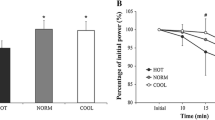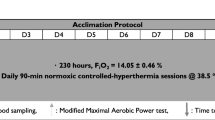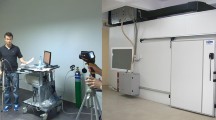Abstract
Sixteen male students exercised for 14 days (1 h/day) in the heat for heat acclimation (HA). During deacclimation (DA) one group exercised in the cold (EXG, n=8) for 60 min/day (morning) and was exposed to the cold for another hour (afternoon) for 14 days. The other group was exposed to the cold (EPG, n=8) for 1 h each in the morning and afternoon (Ta: 18.0°C, RH: 58%) over the same period. All returned to exercise in the heat for reacclimation (RA) for 10 days. Subjects were tested on days 1, 16, 21, 32, 36 and 44 on a bicycle ergometer for 60 min at 60% of VO2max in the heat (Ta: 31.1°C, RH: 70%). Rectal temperature (T re) and heart rate (HR) at 40 min of exercise were used to determine the decay/gain of HA, which was calculated using the formula described by Pandolf et al. (Ergonomics, 20:399–408, 1977). After HA (day 16) T re and HR decreased significantly. During DA, EXG showed decay in T re of 24 and 35% and HR of 29 and 35% on days 21 and 32, respectively. For EPG the corresponding decay was of 2 and 9% for T re and 17 and 17% for HR. After 10 days of RA, EXG showed gains of 11% in T re and 12% in HR, while EPG showed gains of 47% in T re and 38% in HR. In conclusion, EXG had greater decay during DA and lower gains in RA compared to EPG. However, the differences between groups were significant only for T re after 4 days of DA.

Similar content being viewed by others
References
Adam JM, Fox RH, Grimby G, Wolff HS (1960) Acclimatization to heat and its rate of decay in man. J Physiol 152:26–27
Adams WC, Fox RH, Fry AJ, MacDonald IC (1975) Thermoregulation during running in cool, moderate and hot environment. J Appl Physiol 38:1030–1037
American College of Sports Medicine (ACSM) (1996) Exercise and fluid replacement. Pos Stand Med Sci Sports Exerc 28:i–vii
Armstrong LE (2000) Performing in extreme environments. Hum Kinet US, pp 28–29
Armstrong LE, Maresh CM (1991) The induction and decay of heat acclimatization in trained athletes. Sports Med N Z 12:302–312
Banister EW, Allen IB, Mekjavic IB, Singh AK, Legge B, Mutch BJC (1983) The time course of ammonia and lactate accumulation in blood during bicycle exercise. Eur J Appl Physiol 51:195–202
Bean WB, Eichna LW (1943) Performance in relation to environmental temperature: reactions of normal young men to simulated desert environment. Fed Proc 2:144–158
Borg G (1970) Perceived exertion as indicator of somatic stress. Scand J Rehabilition Med 2:92–98
Bruck K, Olschewski H (1987) Body temperature related factors diminishing the drive to exercise. Can J Physiol Pharmacol 65:1274–1280
Fink WJ, Costill DL, Van Handel PJ (1975) Leg muscle metabolism during exercise in the heat and cool. Eur J Appl Physiol Occup Physiol 34:183–190
Fox RH, Goldsmith R, Kidd DJ, Lewis HE (1963) Blood flow and other thermoregulatory changes with acclimatization to heat. J Physiol Lond 166:548–562
Givoni B, Goldman RF (1973) Predicting effects of heat acclimatization on HR and rectal temperature. J Appl Physiol 35:875–879
Henschel A, Taylor HL, Keys A (1943) The persistence of heat acclimatization in man. Am J Physiol 140:321–325
King DS, Costill DL, Fink WJ, Hargreaves M, Fielding RA (1985) Muscle metabolism during exercise in the heat in unacclimatized and acclimatized human. J Appl Physiol 59:1350–1354
Kirwan JP, Costill DL, Kuipers H, Burrell MJ, Fink WJ, Kovaleski JE, Fielding RA (1987) Substrate utilization in leg muscle of men after heat acclimation. J Appl Physiol 63:31–35
Lind AR, Bass DEB (1963) Optimal exposure time for development of acclimatization to heat. Fed Proc 22:704–708
Nielsen B (1994) Heat stress and acclimation. Ergonomis 37(1):49–58
Nielsen B, Savard G, Richter EA, Hargreaves M, Saltin B (1990) Muscle blood flow and muscle metabolism during exercise and heat stress. J Appl Physiol 69:1040–1046
Nielsen B, Hales JRS, Strange S, Juel Christensen N, Warberg J, Saltin B (1993) Human circulatory and thermoregulatory adaptations with heat acclimation and exercise in a hot, dry environment. J Physiol Lond 460:467–485
Pandolf KB (2001) Rated perceived exertion during exercise in the heat, cold or at high altitude. Int J Sport Psycho 32:162–176
Pandolf KB (1998) Time course of heat acclimation and its decay. Int J Sports Med 19:S157–S160
Pandolf KB, Burse RL, Goldman RF (1977) Role of physical fitness in heat acclimatization, decay and reinduction. Ergonomics 20:399–408
Saltin B, Gagge P, Bergh U, Stolwijk JAJ (1972) Body temperature and sweating during exhaustive exercise. J Appl Physiol 32:635–643
Singh R, Singh HJ, Sirisinghe RG (1989) Cardiopulmonary fitness in a sample of Malaysia population. Jpn J Physiol 39:475–485
Williams CG, Wyndham CH, Morrison JF (1967) Rate of loss of acclimatization in summer and winter. J Appl Physiol 22:21–26
Wyndham CH (1951) Effect of acclimatization on circulatory responses to high environmental temperature. J Appl Physiol 4:383–395
Wyndham CH, Jacobs GE (1957) Loss of acclimatization after 6 days works in cool conditions on the surface of a mine. J Appl Physiol 11:197–198
Young AJ, Sawka MN, Levine L, Cadarette BS, Pandolf KB (1985) Skeletal muscle metabolism during exercise is influenced by heat acclimation. J Appl Physiol 59:1929–1935
Acknowledgements
The authors wish to acknowledge the research grants from the Grant-in-Aid for the twenty-first Century COE programme a Grant-in Aid for Scientific Research (16107006), the Japan Society of the Promotion Sciences (JSPS) and the Universiti Sains Malaysia (304/PPSP/6131256) that enabled this study to be conducted.
Author information
Authors and Affiliations
Corresponding author
Rights and permissions
About this article
Cite this article
Saat, M., Sirisinghe, R.G., Singh, R. et al. Decay of heat acclimation during exercise in cold and exposure to cold environment. Eur J Appl Physiol 95, 313–320 (2005). https://doi.org/10.1007/s00421-005-0012-9
Accepted:
Published:
Issue Date:
DOI: https://doi.org/10.1007/s00421-005-0012-9




